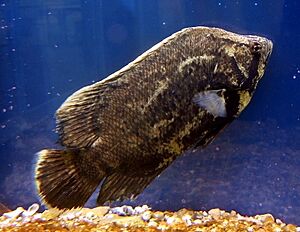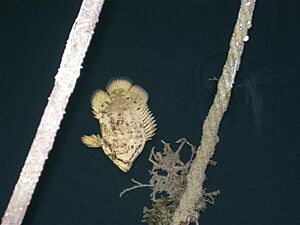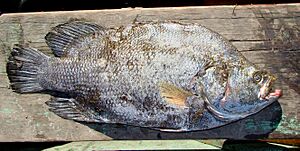Atlantic tripletail facts for kids
Quick facts for kids Atlantic tripletail |
|
|---|---|
 |
|
| Adult | |
 |
|
| juvenile | |
| Conservation status | |
| Scientific classification | |
| Synonyms | |
|
The Atlantic tripletail (Lobotes surinamensis) is a cool type of ray-finned fish. It's also known by many other names like black grunt or sleepfish. This fish gets its name because its fins make it look like it has three tails! You can find this interesting fish in warm, tropical and subtropical waters all over the world. The only place it's not found is the eastern Pacific Ocean.
Contents
Discovering the Atlantic Tripletail
The Atlantic tripletail was first officially described in 1790. A German doctor and naturalist named Marcus Elieser Bloch gave it the scientific name Holocentrus surinamensis. He found it near Suriname in the Caribbean Sea. Later, in 1830, another scientist named Georges Cuvier created a new group, or genus, for this fish called Lobotes. Today, the Atlantic tripletail is the main fish in the Lobotidae family.
What Does the Tripletail Look Like?
The Atlantic tripletail has a body shaped like an oval or a diamond. It's also quite flat from side to side. Its mouth can stick out a little bit. Inside its mouth, it has small, sharp teeth in the front and smaller teeth behind them.
Fins and Colors
This fish has a long fin on its back (dorsal fin) and another on its belly (anal fin). The soft parts of these fins are tall and rounded. They extend far back, making it look like the fish has three tails! Its actual tail fin is rounded too.
Adult tripletails are usually dark brown or greenish-yellow on top. Their lower body is a grayish-silver color. Their front fins are pale yellow, while the other fins are darker. The tail fin often has a yellow edge. These fish can grow up to about 110 centimeters (about 3.6 feet) long, but they are usually around 80 centimeters (about 2.6 feet). Young tripletails have a mix of yellow, brown, and black spots, which helps them blend in.
Where Do Tripletails Live?
The Atlantic tripletail is the only fish in its family that lives in the Atlantic Ocean. But you can find it in many other warm seas too! It's very common in places like Indonesia, where people often see it in local fish markets.
Finding Tripletails in the Americas
In the United States, Atlantic tripletails live from Massachusetts down to Argentina. They are also found in the eastern Atlantic, including the Mediterranean Sea, and in the western Pacific, from Japan to Fiji. They don't usually go too far north of Chesapeake Bay. Along the Gulf Coast, they are present from April to October. Then, they move to warmer waters for the winter. In spring, they gather in specific spots like Port Canaveral, Florida, and Jekyll Island, Georgia. Sometimes, a tripletail might even be seen as far north as the United Kingdom!
Tripletail Homes and Habits
Atlantic tripletails live near the coast in most tropical and subtropical seas. They often travel and can be found in open water. Usually, they prefer to be alone, but sometimes they swim in groups. During the summer, you might find them in bays, sounds, and estuaries (where rivers meet the sea).
Hiding and Hunting
Young tripletails often swim under patches of floating Sargassum algae. Adult tripletails in the Gulf of Mexico are usually in open water. However, they can also be found near river mouths. Big adults sometimes float near the surface in deep water, always close to something floating. Younger fish also like to hide near shipwrecks, docks, jetties, or floating trash and buoys.
Tripletails are famous for a special trick: they float just below the surface, often on their side, looking like a leaf or a piece of trash. They can also change their color from light to dark shades. These behaviors help young fish hide from predators. It's also a clever way for them to hunt! By looking like floating debris, they can get very close to smaller fish or crabs that are hiding in the same floating stuff. Then, they ambush their prey. This unique behavior has made them popular with recreational fishermen. Because of this, rules have been put in place in places like Florida and Georgia to limit how many fish can be caught, helping to protect their populations.
Tripletail Life: Diet and Family
What Do Tripletails Eat?
Atlantic tripletails are not picky eaters. They eat many different things! Their diet mainly includes small fish like gulf menhaden and anchovies. They also enjoy eating invertebrates such as blue crabs and brown shrimp, along with other creatures that live on the seafloor.
How Tripletails Reproduce
Tripletails usually lay their eggs in the summer, especially in July and August. They spawn in open water. A female can produce a huge number of eggs, up to 700,000 at one time! These eggs float in the water. The baby fish, called larvae, also float and change a lot as they grow. Males become ready to reproduce at a smaller size and younger age than females. Coastal Georgia is an important area for tripletails to spawn.
Who Hunts the Tripletail?
Atlantic tripletails don't have many enemies, but larger predators do hunt them. These include sharks, barracudas, and other big fish. Young tripletails can also be caught by birds like pelicans and gulls. These birds are often attracted to the floating debris where the young fish hide.
Tiny Hitchhikers: Tripletail Parasites
Like many animals, tripletails can have tiny creatures called parasites living on or inside them. Some of these are small crustaceans called copepods. For example, Anuretes heckelii can affect their gills, and Lernanthropus pupa can live on their gill filaments.
Why Tripletails Are Important to People
Atlantic tripletails are caught for food, especially off the coasts of Florida. They are sold fresh, frozen, or salted. Fishermen usually catch them using large nets or fishing lines. Sometimes, they are accidentally caught in nets meant for tuna. Tripletails are also a favorite fish for people who enjoy recreational fishing. Their meat is considered very tasty, even better than some other popular game fish.
Protecting the Tripletail
The International Union for Conservation of Nature (IUCN) lists the Atlantic tripletail as a "least-concern species." This means they are not currently in danger of disappearing. To help keep their populations healthy, both Florida and Georgia have rules for recreational fishing. In both states, you can only catch two tripletails per day, and they must be at least 18 inches long.




